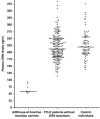Plasma progranulin levels predict progranulin mutation status in frontotemporal dementia patients and asymptomatic family members
- PMID: 19158106
- PMCID: PMC2664450
- DOI: 10.1093/brain/awn352
Plasma progranulin levels predict progranulin mutation status in frontotemporal dementia patients and asymptomatic family members
Abstract
Mutations in the progranulin gene (GRN) are an important cause of frontotemporal lobar degeneration (FTLD) with ubiquitin and TAR DNA-binding protein 43 (TDP43)-positive pathology. The clinical presentation associated with GRN mutations is heterogeneous and may include clinical probable Alzheimer's disease. All GRN mutations identified thus far cause disease through a uniform disease mechanism, i.e. the loss of functional GRN or haploinsufficiency. To determine if expression of GRN in plasma could predict GRN mutation status and could be used as a biological marker, we optimized a GRN ELISA and studied plasma samples of a consecutive clinical FTLD series of 219 patients, 70 control individuals, 72 early-onset probable Alzheimer's disease patients and nine symptomatic and 18 asymptomatic relatives of GRN mutation families. All FTLD patients with GRN loss-of-function mutations showed significantly reduced levels of GRN in plasma to about one third of the levels observed in non-GRN carriers and control individuals (P < 0.001). No overlap in distributions of GRN levels was observed between the eight GRN loss-of-function mutation carriers (range: 53-94 ng/ml) and 191 non-GRN mutation carriers (range: 115-386 ng/ml). Similar low levels of GRN were identified in asymptomatic GRN mutation carriers. Importantly, ELISA analyses also identified one probable Alzheimer's disease patient (1.4%) carrying a loss-of-function mutation in GRN. Biochemical analyses further showed that the GRN ELISA only detects full-length GRN, no intermediate granulin fragments. This study demonstrates that using a GRN ELISA in plasma, pathogenic GRN mutations can be accurately detected in symptomatic and asymptomatic carriers. The approximately 75% reduction in full-length GRN, suggests an unbalanced GRN metabolism in loss-of-function mutation carriers whereby more GRN is processed into granulins. We propose that plasma GRN levels could be used as a reliable and inexpensive tool to identify all GRN mutation carriers in early-onset dementia populations and asymptomatic at-risk individuals.
Figures



Comment in
-
Progranulin plasma levels in the diagnosis of frontotemporal dementia.Brain. 2009 Mar;132(Pt 3):568-9. doi: 10.1093/brain/awp009. Epub 2009 Feb 17. Brain. 2009. PMID: 19224898 Free PMC article. No abstract available.
References
-
- Baker M, Mackenzie IR, Pickering-Brown SM, Gass J, Rademakers R, Lindholm C, et al. Mutations in progranulin cause tau-negative frontotemporal dementia linked to chromosome 17. Nature. 2006;442:916–9. - PubMed
-
- Bateman A, Bennett HP. Granulins: the structure and function of an emerging family of growth factors. J Endocrinol. 1998;158:145–51. - PubMed
-
- Benussi L, Binetti G, Sina E, Gigola L, Bettecken T, Meitinger T, et al. A novel deletion in progranulin gene is associated with FTDP-17 and CBS. Neurobiol Aging. 2008;29:427–35. - PubMed
Publication types
MeSH terms
Substances
Grants and funding
LinkOut - more resources
Full Text Sources
Other Literature Sources
Medical
Miscellaneous

